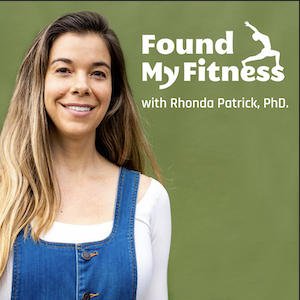Tim Ferriss discusses vitamin C with Rhonda Patrick
Get the full length version of this episode as a podcast.
This episode will make a great companion for a long drive.
The Omega-3 Supplementation Guide
A blueprint for choosing the right fish oil supplement — filled with specific recommendations, guidelines for interpreting testing data, and dosage protocols.
The bioavailability of vitamin C differs appreciably between oral and intravenous administration. Intravenous vitamin C produces higher blood concentrations than taking the supplement orally. Vitamin C is continually cycling between a reduced and an oxidized state. Dr. Patrick theorizes that the oxidized state of vitamin C, acting as a pro-oxidant, has the potential to kill cancer cells. Cancer cells have circumvented death; however, with a small prompt they can be induced to die. In this clip, Tim Ferriss and Dr. Rhonda Patrick discuss the potential use of intravenous vitamin C as a supportive factor in the treatment of cancer.
- Tim: One thing that I've been pondering, I'm not an expert in this area, but vitamin C, if you look at protocols being used at, say, the University of Kansas for antiviral purposes or anti-cancer purposes, the vitamin C is thought of when it's delivered intravenously as a pro-oxidant. So then I'm wondering could you use vitamin C in a pro-oxidant capacity, or I guess it's being converted into like hydrogen peroxide, to not mitigate but exaggerate the benefits you want of, say, intermittent fasting.
- Rhonda: That's interesting. Yeah.
- Tim: If you were doing not even necessarily intermittent. Let's say you do a seven-day water fast. Could you do like 50 to 75 grams of vitamin C each day? Would that end up nullifying a lot of the effects or dramatically enhancing the effects?
- Rhonda: So here are my thoughts. I'm speculating here. Intravenous vitamin C, you get much higher, up to millimolar concentrations of vitamin C in your blood. So vitamin C is constantly going through the cycle of being reduced and oxidized and reduced and oxidized. When it's oxidized, it can act as a pro-oxidant. That's part of the way it kills cancer cells because cancer cells, they're ready to die but they've found a way around death by increasing all these genes that stop them from dying. But all they need is a little push. That little push is like reactive oxygen species or a pro-oxidant like vitamin C. It just pops them, pushes them to death. So intermittent fasting, for example, one of the benefits of intermittent fasting is that your autophagy occurs. Your body is clearing out all these damaged cells. So that would, in theory, if you've got damaged cells . . . so, the problem is with damaged cells, if they don't die, they become senescent. When they're senescent, they sit around and they secrete pro-inflammatory cytokines. So then they damage nearby cells because the inflammatory cytokines. So it's like this vicious cycle and it's why you need to get them back.
- Tim: You need to get the cellular Zamboni to clear that stuff.
- Rhonda: That's a funny analogy. I used to be an ice skater.
- Tim: That's my ring name. Oh, really?
- Rhonda: For many, many years I was a competitive ice skater, both freestyle and drills team. So you want to clear them out. I would think that if you have this senescent cell, that would help get rid of it. So very, very interesting.
An intracellular degradation system involved in the disassembly and recycling of unnecessary or dysfunctional cellular components. Autophagy participates in cell death, a process known as autophagic dell death. Prolonged fasting is a robust initiator of autophagy and may help protect against cancer and even aging by reducing the burden of abnormal cells.
The relationship between autophagy and cancer is complex, however. Autophagy may prevent the survival of pre-malignant cells, but can also be hijacked as a malignant adaptation by cancer, providing a useful means to scavenge resources needed for further growth.
A broad category of small proteins (~5-20 kDa) that are important in cell signaling. Cytokines are short-lived proteins that are released by cells to regulate the function of other cells. Sources of cytokines include macrophages, B lymphocytes, mast cells, endothelial cells, fibroblasts, and various stromal cells. Types of cytokines include chemokines, interferons, interleukins, lymphokines, and tumor necrosis factor.
A broad term that describes periods of voluntary abstention from food and (non-water) drinks, lasting several hours to days. Depending on the length of the fasting period and a variety of other factors, intermittent fasting may promote certain beneficial metabolic processes, such as the increased production of ketones due to the use of stored fat as an energy source. The phrase “intermittent fasting” may refer to any of the following:
- Time-restricted eating
- Alternate-day fasting
- Periodic fasting (multi-day)
Highly reactive molecules that have the ability to oxidize other molecules and cause them to lose electrons. Common oxidants are oxygen, hydrogen peroxide, and superoxide anion.
Senescence is a response to stress in which damaged cells suspend normal growth and metabolism. While senescence is vital for embryonic development, wound healing, and cancer immunity, accumulation of senescent cells causes increases inflammation and participates in the phenotype of aging.
A potent water-soluble antioxidant found in citrus fruits. Vitamin C is an essential nutrient involved in tissue repair, neurotransmission, and immune system function. Also known as ascorbic acid.
Get email updates with the latest curated healthspan research
Support our work

Every other week premium members receive a special edition newsletter that summarizes all of the latest healthspan research.

















